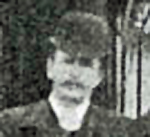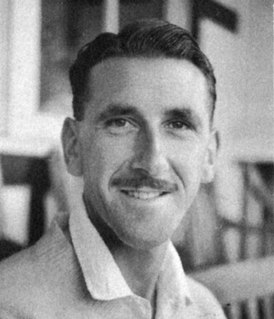Related Research Articles
Jack Birkenshaw, was an English cricketer, who later stood as an umpire and worked as a coach. Cricket commentator, Colin Bateman, stated "Jack Birkenshaw was the epitome of a good all-round county cricketer: a probing off-spinner who used flight and guile, a handy batsman who could grind it out or go for the slog, a dependable fielder and great competitor".
Edmund Hinkly was an English professional cricketer, most notable for being the first man known to have taken all ten wickets in a first-class cricket innings in an eleven-a-side game. He achieved this while playing for Kent County Cricket Club against an England XI at Lord's in 1848.
Thomas Armitage was an English first-class cricketer, who in 1877 took part in what are retrospectively recognised as the first two Test matches played by England. The players in these matches having been alphabetically sorted, Armitage is the #1 capped England player.

Willie Bates, known as Billy Bates, was an English cricketer. Skilled with both bat and ball, Bates scored over 10,000 first-class runs, took more than 870 wickets and was always reliable in the field. A snappy dresser, Bates was also known as "The Duke".

Robert William Taylor is an English former cricketer who played as wicket-keeper for Derbyshire between 1961 and 1984 and for England between 1971 and 1984. He made 57 Test, and 639 first-class cricket appearances in total, taking 1,473 catches. The 2,069 victims across his entire career is the most of any wicket-keeper in first-class history. He is considered as one of the world's most accomplished wicket-keepers. He made his first-class debut for Minor Counties against South Africa in 1960, having made his Staffordshire debut in 1958. He became Derbyshire's first choice wicket-keeper when George Dawkes sustained a career-ending injury. His final First Class appearance was at the Scarborough Festival in 1988. He remained first choice until his retirement except for a short period in 1964 when Laurie Johnson was tried as a batsman-wicketkeeper.

Arnold James Fothergill was an English professional cricketer who played first-class cricket for Somerset County Cricket Club and the MCC in a career which spanned from 1870 until 1892. A left-arm fast-medium pace bowler, he appeared for England in two Test matches in 1889.

Roy Kilner was an English professional cricketer who played nine Test matches for England between 1924 and 1926. An all-rounder, he played for Yorkshire County Cricket Club between 1911 and 1927. In all first-class matches, he scored 14,707 runs at an average of 30.01 and took 1,003 wickets at an average of 18.45. Kilner scored 1,000 runs in a season ten times and took 100 wickets in a season five times. On four occasions, he completed the double: scoring 1,000 runs and taking 100 wickets in the same season, recognised as a sign of a quality all-rounder.
Joe Ambler was an English professional first-class cricketer who made eight appearances in county cricket during the 1880s, playing for both Yorkshire and Somerset. A right-handed batsman and right-arm fast-medium paced bowler, Ambler also kept wicket on occasion.

When the First World War ended in November 1918, thousands of Australian servicemen were in Europe as members of the First Australian Imperial Force (AIF) and many remained until the spring of 1919. In England, a new first-class cricket season was planned, the first since 1914, and an idea that came to fruition was the formation of an Australian touring side made up of servicemen. Agreement was reached with the Australian Corps HQ in London, commanded by Field Marshal William Birdwood, 1st Baron Birdwood, and the Australian Imperial Force Touring XI was formed, initially under the captaincy of pre-war Test player Charlie Kelleway. Kelleway departed after only six matches following a dispute about the fixtures list. A players' meeting elected future Test player Herbie Collins as team captain for the remainder of the tour, despite the fact that Collins' military rank was lance corporal and there were seven officers in the party. The bulk of the team remained intact for nearly nine months from May 1919, playing 33 matches in Great Britain, ten in South Africa on their way home and then another three in Australia itself before disbanding in February 1920. Of the 46 matches, 39 are adjudged first-class and the team had only four defeats, all of these in England. The players lived on their army pay and all profits from gate money went to an AIF Sports Control Board.

John "Jack" Crossland was an English professional cricketer who played first-class cricket between 1878 and 1887. Crossland was recognised as one of the fastest bowlers in county cricket, but critics generally believed that he threw, rather than bowled the ball, a practice illegal in cricket. Contemporaries suggest that, but for the suspicions over his bowling action, Crossland would have played Test cricket for England.

Edgar “Ned” Willsher was an English cricketer known for being a catalyst in the shift from roundarm to overarm bowling. A left-handed bowler, and useful lower-order batsman, Willsher played first-class cricket for Kent County Cricket Club between 1850 and 1875. He took over 1,300 first-class wickets, despite only having one lung. He led a tour of Canada and the United States in 1868, and after retiring from his playing career became an umpire (cricket).
Charles Appleton was an English amateur cricketer, who played three matches of first-class cricket for Yorkshire County Cricket Club in 1885, which happened to comprise three of Yorkshire's heaviest defeats. In his six first-class innings he scored 56 runs, with a best of 18, at an average of 11.20. He did not bowl or take a catch. He played against Surrey, an 'All England XI' and Kent, all the matches being held at Bramall Lane, Sheffield. He is notable for making his first-class debut at the advanced age of 41.

George Freeman was an English first-class cricketer. He made thirty-two appearance for Yorkshire County Cricket Club from 1865 to 1880. He also played four matches of first-class cricket for the "United England Eleven" (1866–1869), three games for the "North of England" (1867–1869), four for the "United North of England Eleven" (1870) plus one for the "Players" (1871).
Charles John Gifkins was an English amateur first-class cricketer, who played two matches for Yorkshire County Cricket Club in 1880.

David Hunter was part of a lineage of Yorkshire County Cricket Club wicket-keepers, stretching on through Arthur Dolphin to Arthur Wood, Jimmy Binks and David Bairstow. Hunter played 517 first-class games for Yorkshire between 1888 and 1909.

John Thomas Rawlin was an English first-class cricketer, who played twenty seven matches for Yorkshire County Cricket Club between 1880 and 1885, and 229 matches for Middlesex between 1889 and 1909. He toured Australia with Vernon's team in 1887/89. He also played first-class games for the Marylebone Cricket Club (MCC) from 1887 to 1909.
Stewart James Storey is a former English cricketer. He was an all-rounder, a right-handed middle-order batsman and right-arm medium pace bowler as well as being a fine slip fielder. He played for Surrey from 1960 to 1976, winning the County Championship with them in 1971, and subsequently appeared for Sussex in 1978. He was readily recognisable on the cricket field by his fair hair.

Jack David Shantry is a former English cricketer who played county cricket for Worcestershire.

Frank Henry Vigar was an English cricketer who played first-class cricket for Essex between 1938 and 1954. A right-handed batsman, and leg break bowler, Vigar served as an all-rounder with 8,858 runs at 26.28 and 241 wickets at 37.90. From his rained-off debut in 1938, Vigar went on to play 257 matches for his county. His greatest success came in the "golden summer" of 1947, where he scored 1,735 runs and took 64 wickets. A partnership with Peter Smith of 218 for the final wicket remains an Essex record.
Rory Joseph Burns is an English cricketer who plays for Surrey. He made his international debut for the England cricket team in November 2018. He is a left-handed batsman who opens in first-class cricket and occasionally fields as a wicket-keeper. In 2018, he was appointed captain of Surrey in both first-class and List A formats.
References
- ↑ Warner, David (2011). The Yorkshire County Cricket Club: 2011 Yearbook (113th ed.). Ilkley, Yorkshire: Great Northern Books. p. 362. ISBN 978-1-905080-85-4.